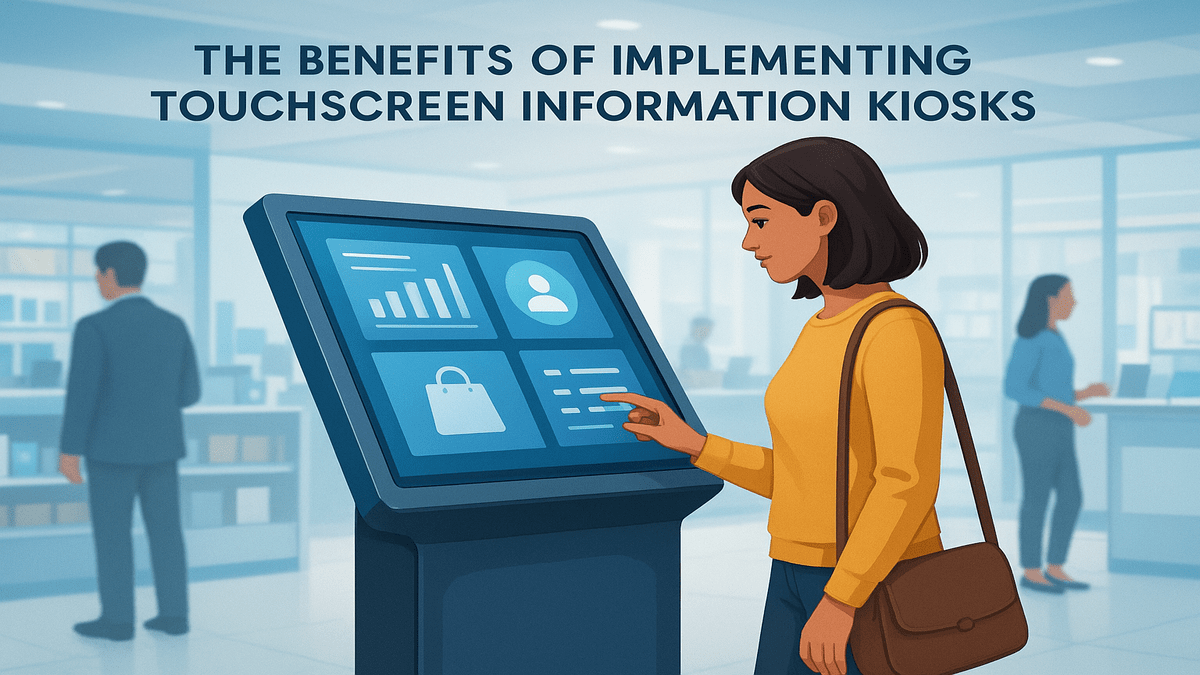In today’s fast-paced business environment, customer experience is more important than ever. Companies are constantly looking for innovative ways to engage customers, streamline operations, and enhance efficiency. One such technology that has gained tremendous popularity over the past few years is the touchscreen information kiosk. These interactive systems are not just futuristic gadgets; they offer tangible benefits that can transform how businesses operate and interact with their clients.
The Benefits of Implementing Touchscreen Information Kiosks are numerous, ranging from improved customer service to operational efficiency and increased sales. By providing users with an intuitive interface, businesses can deliver information quickly and accurately, reducing the dependency on human staff for routine queries. This not only saves time for both employees and customers but also allows staff to focus on more critical tasks that require personal attention.
Introduction: Why Touchscreen Information Kiosks Matter
In today’s fast-paced business environment, speed, accuracy, and the quality of customer experience are more important than ever. Any business that can deliver information quickly and clearly to its customers has a greater chance of attracting and retaining them. One of the key technologies enabling this is touchscreen information kiosks. These interactive systems are not only innovative tools for providing information to customers but also help increase employee productivity, reduce costs, and significantly enhance the shopping or service experience.
In the following sections, we will explore the benefits of implementing touchscreen information kiosks in your business in detail, showing how this technology can create real and tangible positive impacts on operations, customer interactions, and overall business success.
Enhancing Customer Experience
One of the primary advantages of touchscreen kiosks is their ability to enhance customer experience. Modern consumers expect instant access to information. Waiting in long lines or navigating confusing systems can lead to frustration and decreased satisfaction. Touchscreen kiosks allow customers to access product details, store maps, and other relevant information at their own pace. The interactivity of these kiosks creates a sense of control for users, improving their overall perception of the business.
Moreover, integrating features like personalized recommendations or loyalty program information into kiosks can create a more engaging shopping experience. For instance, a customer entering a store could use a kiosk to locate items quickly or receive tailored promotions based on their purchase history. This level of convenience can significantly enhance brand loyalty and increase the likelihood of repeat visits.
 Streamlining Business Operations
Streamlining Business Operations
Another critical aspect of the benefits of implementing touchscreen information kiosks is operational efficiency. Traditional methods of providing information, such as brochures or staff assistance, can be resource-intensive. Touchscreen kiosks automate many of these processes, reducing the workload for employees and minimizing human errors.
For example, in a busy retail environment, kiosks can provide real-time inventory updates. Customers can check product availability themselves, which reduces the number of inquiries directed at staff and speeds up the decision-making process. Similarly, in a hotel or airport setting, kiosks can assist with check-ins, ticketing, or booking services, streamlining operations and improving service quality.
Marketing and Sales Opportunities
Touchscreen information kiosks are not only functional but also powerful marketing tools. Businesses can leverage them to promote products, highlight special offers, or even gather customer feedback. Interactive displays tend to capture attention more effectively than static signage, which increases engagement and potentially boosts sales.
Additionally, kiosks can support multimedia content, such as videos, animations, and interactive catalogs. This versatility allows companies to present their offerings in a dynamic and appealing manner. For example, a kiosk in a clothing store could showcase styling tips, outfit combinations, or even virtual try-on features, creating a richer shopping experience and encouraging more purchases.
Data Collection and Analytics
One often overlooked benefit of implementing touchscreen information kiosks is their ability to gather valuable data. Every interaction with a kiosk can be tracked and analyzed, providing insights into customer behavior, preferences, and frequently asked questions. This data can inform business strategies, improve product offerings, and optimize service delivery.
For instance, a kiosk in a restaurant can track which menu items customers check most frequently, helping management identify trends and adjust inventory accordingly. Similarly, in a healthcare facility, kiosks can record the most commonly requested information, enabling staff to streamline communication and reduce wait times.
 Accessibility and Inclusivity
Accessibility and Inclusivity
Touchscreen kiosks can also make businesses more accessible to a wider audience. Features like multilingual support, text-to-speech capabilities, and adjustable screen heights ensure that more customers can use the system independently. This inclusivity is particularly important in diverse communities or locations with high tourist traffic.
By offering self-service options that cater to different needs, businesses demonstrate a commitment to customer care and inclusivity. This not only enhances the user experience but also helps companies comply with accessibility regulations and standards.
Reducing Operational Costs
Cost reduction is another compelling reason why businesses consider the benefits of implementing touchscreen information kiosks. While there is an initial investment in hardware and software, kiosks can significantly lower ongoing labor costs. Routine tasks, such as providing directions, answering frequently asked questions, or processing simple transactions, can be handled by the kiosk, freeing employees for higher-value activities.
Additionally, kiosks reduce the need for printed materials like brochures, flyers, and signage, which can save money and contribute to sustainability goals. Over time, these savings can offset the upfront costs and deliver a strong return on investment.
Flexibility and Customization
One of the greatest strengths of touchscreen kiosks is their flexibility. Businesses can customize the interface, design, and functionality to meet their specific needs. From simple information screens to fully integrated systems capable of processing payments, kiosks can adapt to various environments, including retail stores, airports, hospitals, and museums.
For companies looking to enhance their branding, kiosks offer a platform to maintain a consistent visual identity. Businesses can incorporate logos, color schemes, and messaging that align with their overall marketing strategy, creating a cohesive and professional appearance.
Integrating Touchscreen Kiosks with Digital Signage
Touchscreen kiosks often work in conjunction with digital signage to maximize their impact. For example, the Digital Display Buying Guide can help businesses select the right type of display for their kiosk setup. Choosing the correct display ensures optimal visibility, durability, and interactivity, which are critical for providing a seamless user experience.
Understanding the Challenges of installing outdoor digital displays is equally important. Factors like weather conditions, sunlight visibility, and vandalism must be considered when deploying kiosks in outdoor settings. Addressing these challenges proactively ensures that the kiosk remains functional and reliable in all conditions.
Design Considerations
Design plays a crucial role in the success of touchscreen kiosks. Following Important tips for designing a Digital Signage to attract customers can enhance user engagement. Intuitive navigation, clear labeling, responsive touch capabilities, and visually appealing layouts all contribute to a positive user experience. Poor design can frustrate users and undermine the very benefits of implementing touchscreen information kiosks.
Maintenance and Longevity
Regular upkeep is essential to ensure kiosks remain operational and effective. Adhering to Tips for maintaining digital signage can extend the life of the hardware and software. Routine checks, software updates, and cleaning of touch surfaces help maintain responsiveness and visual clarity. Proper maintenance minimizes downtime and preserves the kiosk’s ability to serve customers efficiently.
Future Trends
The benefits of implementing touchscreen information kiosks are likely to grow as technology advances. Integration with artificial intelligence (AI), augmented reality (AR), and mobile connectivity can create even more interactive and personalized experiences. For instance, kiosks could use facial recognition to provide tailored recommendations or integrate with mobile apps for seamless transactions.
Moreover, as businesses increasingly prioritize digital transformation, kiosks represent a cost-effective and scalable solution. They bridge the gap between physical and digital experiences, allowing companies to stay competitive in an ever-evolving marketplace.
Conclusion
In conclusion, the benefits of implementing touchscreen information kiosks in your business are multifaceted. From enhancing customer experience and streamlining operations to providing marketing opportunities and reducing costs, these interactive systems offer significant advantages. They also facilitate data collection, improve accessibility, and allow for customization that aligns with branding and business objectives.
By carefully considering design, integration with digital signage, and proper maintenance, businesses can fully leverage the potential of touchscreen kiosks. Whether you operate a retail store, a hotel, a hospital, or a museum, adopting this technology can transform the way you interact with customers, ultimately driving satisfaction, loyalty, and growth.
Embracing touchscreen information kiosks is more than just adopting a new gadget, it is a strategic decision that positions your business for success in the digital age.




